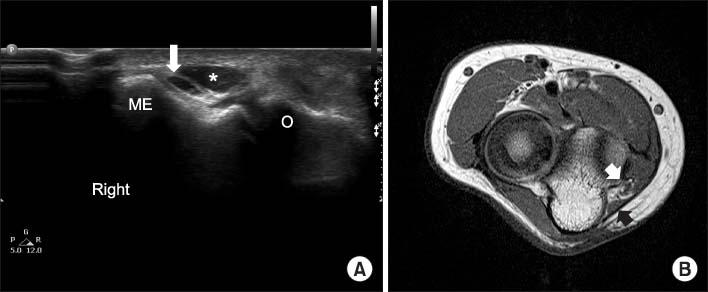J Korean Orthop Assoc.
2014 Aug;49(4):312-315. 10.4055/jkoa.2014.49.4.312.
Cubital Tunnel Syndrome by Anconeus Epitrochlearis in an Adolescent
- Affiliations
-
- 1Department of Orthopedic Surgery, The Catholic University of Korea School of Medicine, Seoul, Korea. sjoo@catholic.ac.kr
- KMID: 2185192
- DOI: http://doi.org/10.4055/jkoa.2014.49.4.312
Abstract
- Compression neuropathy of the ulnar nerve due to anconeus epitrochlearis muscle is rare in adolescents. It is usually known that the hypertrophied muscle in adult or weightlifting athletes compresses the ulnar nerve. There were only few case reports in children and adolescent relevant to athletic activities. In this case, a non-athlete 15-year-old girl developed compression ulnar nerve neuropathy caused by an anconeus epitrochearis muscle. This case is remarkable as an anconeus epitrochearis muscle is uncommon in non-athlete children and adolescent since a literature review revealed no previous report.
Figure
Reference
-
1. Boero S, Sénès FM, Catena N. Pediatric cubital tunnel syndrome by anconeus epitrochlearis: a case report. J Shoulder Elbow Surg. 2009; 18:e21–e23.
Article2. Stutz CM, Calfee RP, Steffen JA, Goldfarb CA. Surgical and nonsurgical treatment of cubital tunnel syndrome in pediatric and adolescent patients. J Hand Surg Am. 2012; 37:657–662.
Article3. Felice KJ, Royden Jones H Jr. Pediatric ulnar mononeuropathy: report of 21 electromyography-documented cases and review of the literature. J Child Neurol. 1996; 11:116–120.
Article4. Masear VR, Hill JJ Jr, Cohen SM. Ulnar compression neuropathy secondary to the anconeus epitrochlearis muscle. J Hand Surg Am. 1988; 13:720–724.
Article5. Lee EW, Chun JM, Lee BJ. Ulnar nerve entrapment syndrome by epitrochleoanconeus muscle - a case report. J Korean Orthop Assoc. 1990; 25:1781–1785.6. Kim BK, Shin HD, Kim KC, Park JY. Tardy ulnar nerve palsy secondary to the anconeus epitrochlearis muscle: 2 case report. Clin Should Elbow. 2010; 13:270–274.7. Jeon IH, Kim PT, Park BC, Ihn JC, Ahn SM. Cubital tunnel syndrome secondary to the anconeus epitrochlearis muscle: a case report. J Korean Soc Surg Hand. 2002; 7:57–60.8. Spinner M. Injuries to the major branches of peripheral nerves of the forearm. Philadelphia: WB Saunders;1972. p. 115–116.9. Vanderpool DW, Chalmers J, Lamb DW, Whiston TB. Peripheral compression lesions of the ulnar nerve. J Bone Joint Surg Br. 1968; 50:792–803.
Article10. Chalmers J. Unusual causes of peripheral nerve compression. Hand. 1978; 10:168–175.
Article
- Full Text Links
- Actions
-
Cited
- CITED
-
- Close
- Share
- Similar articles
-
- Ultrasound Diagnosis of Double Crush Syndrome of the Ulnar Nerve by the Anconeus Epitrochlearis and a Ganglion
- Comparison of Cubital Tunnel Syndrome with or without Anconeus Epitrochlearis: Are They Different?
- Cubital Tunnel Syndrome Caused by Anconeus Epitrochlearis Muscle
- Ulnar Neuropathy due to Cubital Tunnel Syndrome Caused by Anconeus Epitrochlearis: A Case Report
- Tardy Ulnar Nerve Palsy Secondary to the Anconeus Epitrochlearis Muscle: 2 Case Report



